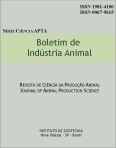Morphological composition of cultivar of Urochloa brizantha under light intensities
Keywords:
forage production, light interception, shadingAbstract
The implementation of silvopastoral systems (SSP) is a management option that gives good results for animal production, but the shading of the trees can alter production, growth behavior and morphological composition of the forage. The aim of the study was to evaluate the morphological composition of Urochloa brizantha cultivars Marandu and Piatàunder natural light and artificial shading of 30 and 60%. The experiment was conducted at FMVZ - UNESP, Botucatu. The experimental design was a randomized block in factorial arrangement 3 x 2 (three shading levels: 0, 30 and 60% and two cultivars: Marandu and Piatã) with three replications and repeated measures in time (3 cuts). Sample collection occurred when the cultivars reached in 35 cm of height. Significant effects (P<0.05) of cultivar x shade x cut interaction were observed on the dry matter production of leaves and stems (Table 1). The higher production of leaves and stems (P<0.05) occurred for Piatàunder natural light in the third cut (3731 and 1920 kg/ha, respectively). The absence of shade favored greater leaf production, 35 and 27% higher than the reductions of 30 and 60% respectively. The increment of stems for Piatàunder natural light is related to the increase of inflorescences. The leaf:stem ratio was higher (P< 0.05 ) for Marandu under natural light (Table 2), with effect from the interaction cultivar x brightness level. A significant effect (P<0.05) cultivar x level of light reduction for light interception parameter was detected (Table 2). For Marandu, light levels were not influenced (P<0.05 ) light traps (Table 2), being close to the 95% criterion used for pasture management, justified by the collection at the point of balance between forage productivity and nutritional content, and strong relationship with high input grazing. The results indicate that the morphological composition of the cultivars is modified by reducing the light intensity.
Downloads
Downloads
Published
Issue
Section
License
Os autores não serão remunerados pela publicação de trabalhos, pois devem abrir mão de seus direitos autorais em favor deste periódico. Por outro lado, os autores ficam autorizados a publicar seus artigos, simultaneamente, em repositórios da instituição de sua origem, desde que citada a fonte da publicação original seja Boletim de Indústria Animal. A revista se reserva o direito de efetuar, nos originais, alterações de ordem normativa, ortográfica e gramatical, com vistas a manter o padrão culto da língua e a credibilidade do veículo. Respeitará, no entanto, o estilo de escrever dos autores. Alterações, correções ou sugestões de ordem conceitual serão encaminhadas aos autores, quando necessário. Nesses casos, os artigos, depois de adequados, deverão ser submetidos a nova apreciação. As opiniões emitidas pelos autores dos artigos são de sua exclusiva responsabilidade. Todo o conteúdo deste periódico, exceto onde está identificado, está licenciado sob a Licença Creative Commons Attribution (CC-BY-NC). A condição BY implica que os licenciados podem copiar, distribuir, exibir e executar a obra e fazer trabalhos derivados com base em que só se dão o autor ou licenciante os créditos na forma especificada por estes. A cláusula NC significa que os licenciados podem copiar, distribuir, exibir e executar a obra e fazer trabalhos derivados com base apenas para fins não comerciais.













